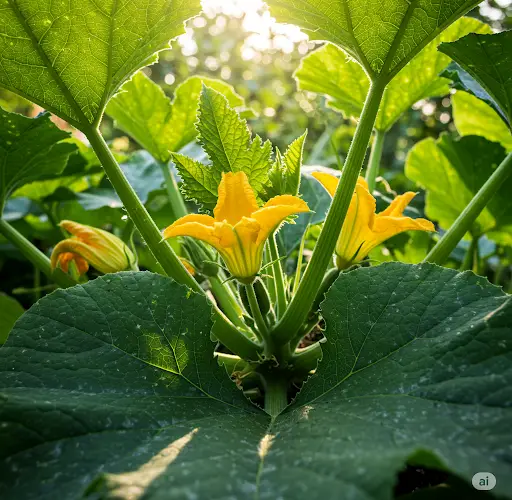Squash plants are a popular choice for many gardeners thanks to their prolific yields and delicious fruit. However, like many garden crops, squash can fall victim to pests that reduce harvests and damage plants. Common pests such as squash vine borers, aphids, cucumber beetles, and powdery mildew can quickly weaken your plants if not managed properly.
Fortunately, two simple yet effective techniques—vertical training and pruning—can significantly reduce pest problems and improve plant health. By keeping your squash vines off the ground and maintaining good airflow, you create an environment less hospitable to pests and diseases. This article explains how vertical training and pruning can protect your squash, along with practical tips to apply these methods in your garden.
Why Are Squash Plants Vulnerable to Pests?
Squash plants typically grow sprawling vines that spread across the ground, making their leaves and fruit easy targets for insects and fungal diseases. The dense foliage often traps moisture, creating ideal conditions for powdery mildew and other fungal pathogens. Ground contact also facilitates the spread of soil-borne diseases and makes it easier for crawling pests like slugs and beetles to access the plants.
Furthermore, squash vine borers, which lay eggs at the base of the plant, can burrow into the stems, causing wilting and plant death. Preventing these pests from gaining easy access is essential for a healthy crop.
Vertical Training: Lifting Your Squash Off the Ground
Vertical training involves supporting squash vines to grow upward rather than sprawling across the soil. This can be done using trellises, stakes, cages, or other sturdy frameworks.
Benefits of vertical training include:
-
Improved air circulation: Lifting the foliage allows better airflow, reducing humidity and lowering fungal disease risks.
-
Easier pest monitoring: Pests are more visible and easier to control when plants are elevated.
-
Cleaner fruit: Fruits hanging off the ground are less likely to rot or be eaten by ground pests.
-
Space efficiency: Vertical growing saves garden space and can increase yields per square foot.
How to Vertically Train Your Squash
-
Choose a sturdy support: Use a strong trellis made of wood, metal, or wire mesh. Ensure it can hold the weight of mature squash fruit.
-
Plant near the support: Plant squash at the base of the trellis to allow vines to climb naturally.
-
Guide young vines: As new shoots grow, gently tie or weave them onto the trellis using soft garden ties or twine. Avoid tight knots to prevent damage.
-
Prune excess growth: Encourage upward growth by removing side shoots and weak vines that do not climb effectively.
-
Harvest regularly: Regular picking encourages continued flowering and fruit production.
Vertical training works well with many squash varieties, especially vining types like zucchini, butternut, and acorn squash.
Pruning: Keeping Your Squash Healthy and Pest-Free
Pruning involves selectively removing leaves, shoots, or stems to improve plant health and productivity.
Benefits of pruning include:
-
Better airflow: Thinning dense foliage reduces humidity and fungal disease risk.
-
Reduced pest habitat: Fewer leaves and less dense growth minimize shelter for aphids, beetles, and other pests.
-
Improved sunlight penetration: Sunlight reaching more parts of the plant promotes growth and fruit ripening.
-
Stronger plants: Pruning redirects energy to healthy parts of the plant, boosting vigor.
Pruning Tips for Squash
-
Remove dead or yellowing leaves: These can harbor pests and diseases.
-
Cut back overcrowded areas: Thin out clusters of leaves to allow air and light circulation.
-
Pinch or prune lateral shoots: Removing excessive side shoots can focus energy on main vines and fruit.
-
Avoid heavy pruning: Squash plants rely on leaves for photosynthesis, so prune moderately to avoid stressing the plant.
-
Sanitize tools: Always use clean, sharp pruning shears to prevent disease spread.
Combining Vertical Training and Pruning for Pest Protection
Using vertical training and pruning together creates an optimal growing environment that discourages pests and diseases naturally:
-
Pests like squash vine borers have a harder time reaching the plant base when vines are elevated and pruned.
-
Better air circulation reduces fungal infections that attract insects.
-
Cleaner fruit is less susceptible to soil-borne pathogens and pests.
-
Regular monitoring is easier, allowing quick intervention before infestations spread.
Additional Tips to Keep Squash Pest-Free
-
Inspect plants regularly: Early detection of pests allows timely control.
-
Use organic deterrents: Neem oil, insecticidal soaps, or diatomaceous earth can help manage common pests.
-
Encourage beneficial insects: Ladybugs and lacewings prey on aphids and other harmful insects.
-
Practice crop rotation: Avoid planting squash in the same spot each year to reduce soil pests.
-
Maintain good garden hygiene: Remove plant debris and weeds to limit pest habitats.
Final Thoughts
Vertical training and pruning are simple yet highly effective methods to protect your squash plants from pests and diseases. By lifting vines off the ground and keeping foliage manageable, you create a healthier environment that reduces pest pressure and promotes stronger growth.
Implementing these techniques in your garden will lead to cleaner, more vigorous plants and a more abundant squash harvest. Alongside regular monitoring and integrated pest management, vertical training and pruning can help you enjoy a thriving and pest-resistant squash patch season after season.



